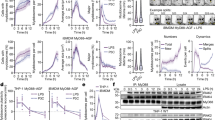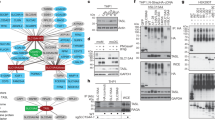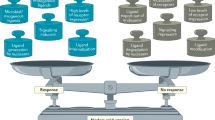Abstract
Mammalian Toll-like receptors (TLRs) function as sensors of infection and induce the activation of innate and adaptive immune responses1,2,3. Upon recognizing conserved pathogen-associated molecular products, TLRs activate host defence responses through their intracellular signalling domain, the Toll/interleukin-1 receptor (TIR) domain, and the downstream adaptor protein MyD88 (refs 1–3). Although members of the TLR and the interleukin-1 (IL-1) receptor families all signal through MyD88, the signalling pathways induced by individual receptors differ. TIRAP, an adaptor protein in the TLR signalling pathway, has been identified and shown to function downstream of TLR4 (refs 4, 5). Here we report the generation of mice deficient in the Tirap gene. TIRAP-deficient mice respond normally to the TLR5, TLR7 and TLR9 ligands, as well as to IL-1 and IL-18, but have defects in cytokine production and in activation of the nuclear factor NF-κB and mitogen-activated protein kinases in response to lipopolysaccharide, a ligand for TLR4. In addition, TIRAP-deficient mice are also impaired in their responses to ligands for TLR2, TLR1 and TLR6. Thus, TIRAP is differentially involved in signalling by members of the TLR family and may account for specificity in the downstream signalling of individual TLRs.
This is a preview of subscription content, access via your institution
Access options
Subscribe to this journal
Receive 51 print issues and online access
$199.00 per year
only $3.90 per issue
Buy this article
- Purchase on SpringerLink
- Instant access to full article PDF
Prices may be subject to local taxes which are calculated during checkout





Similar content being viewed by others
References
Akira, S., Takeda, K. & Kaisho, T. Toll-like receptors: critical proteins linking innate and acquired immunity. Nature Immunol. 2, 675–680 (2001)
Aderem, A. & Ulevitch, R. J. Toll-like receptors in the induction of the innate immune response. Nature 406, 782–787 (2000)
Medzhitov, R. Toll-like receptors and innate immunity. Nature Rev. Immunol. 1, 135–145 (2001)
Horng, T., Barton, G. & Medzhitov, R. TIRAP, an adapter molecule in the Toll signaling pathway. Nature Immunol. 2, 835–841 (2001)
Fitzgerald, K. A. et al. Mal (MyD88-adapter-like) is required for Toll-like receptor-4 signal transduction. Nature 413, 78–83 (2001)
Poltorak, A. et al. Defective LPS signaling in C3H/HeJ and C57BL/10ScCr mice: mutations in Tlr4 gene. Science 282, 2085–2088 (1998)
Alexopoulou, L., Holt, A. C., Medzhitov, R. & Flavell, R. A. Recognition of double-stranded RNA and activation of NF-κB by Toll-like receptor 3. Nature 413, 732–738 (2001)
Takeuchi, O. et al. Differential roles of TLR2 and TLR4 in recognition of Gram-negative and Gram-positive bacterial cell wall components. Immunity 11, 443–451 (1999)
Aliprantis, A. O. et al. Cell activation and apoptosis by bacterial lipoproteins through toll- like receptor-2. Science 285, 736–739 (1999)
Brightbill, H. D. et al. Host defense mechanisms triggered by microbial lipoproteins through toll-like receptors. Science 285, 732–736 (1999)
Underhill, D. M., Ozinsky, A., Smith, K. D. & Aderem, A. Toll-like receptor-2 mediates mycobacteria-induced proinflammatory signaling in macrophages. Proc. Natl Acad. Sci. USA 96, 14459–14463 (1999)
Hayashi, F. et al. The innate immune response to bacterial flagellin is mediated by Toll-like receptor 5. Nature 410, 1099–1103 (2001)
Hemmi, H. et al. Toll-like receptor recognizes bacterial DNA. Nature 408, 740–745 (2000)
Underhill, D. M. & Ozinsky, A. Toll-like receptors: key mediators of microbe detection. Curr. Opin. Immunol. 14, 103–110 (2002)
Kaisho, T., Takeuchi, O., Kawai, T., Hoshino, K. & Akira, S. Endotoxin-induced maturation of myd88-deficient dendritic cells. J. Immunol. 166, 5688–5694 (2001)
Kawai, T. et al. Lipopolysaccharide stimulates the MyD88-independent pathway and results in activation of IFN-regulatory factor 3 and the expression of a subset of lipopolysaccharide-inducible genes. J. Immunol. 167, 5887–5894 (2001)
Kawai, T., Adachi, O., Ogawa, T., Takeda, K. & Akira, S. Unresponsiveness of MyD88-deficient mice to endotoxin. Immunity 11, 115–122 (1999)
Takeuchi, O. et al. Cutting edge: role of toll-like receptor 1 in mediating immune response to microbial lipoproteins. J. Immunol. 169, 10–14 (2002)
Ozinsky, A. et al. The repertoire for pattern recognition of pathogens by the innate immune system is defined by cooperation between toll-like receptors. Proc. Natl Acad. Sci. USA 97, 13766–13771 (2000)
Kopp, E. & Ghosh, S. Inhibition of NF-κB by sodium salicylate and aspirin. Science 265, 956–959 (1994)
Acknowledgements
We thank S. Akira for the MyD88-deficient mice; L. Kopp and C. Pasare for discussion and reading the manuscript; C. Annicelli for maintaining the mouse colony; L. Evangeliate for technical assistance; L. Alexopoulou and K. Kobayashi for technical advice; and the Yale Cancer Center Transgenic Mouse and Gene Targeting Resource for blastocyst injections. This work was supported by the NIH, the Searle Foundation (R.M.) and the Howard Hughes Medical Institute (R.M., T.H., G.B. and R.F.).
Author information
Authors and Affiliations
Corresponding author
Ethics declarations
Competing interests
The authors declare that they have no competing financial interests.
Rights and permissions
About this article
Cite this article
Horng, T., Barton, G., Flavell, R. et al. The adaptor molecule TIRAP provides signalling specificity for Toll-like receptors. Nature 420, 329–333 (2002). https://doi.org/10.1038/nature01180
Received:
Accepted:
Issue Date:
DOI: https://doi.org/10.1038/nature01180
This article is cited by
-
Emerging strategies for treating autoimmune disease with genetically modified dendritic cells
Cell Communication and Signaling (2024)
-
TIRAP-mediated activation of p38 MAPK in inflammatory signaling
Scientific Reports (2022)
-
Protein N-myristoylation: functions and mechanisms in control of innate immunity
Cellular & Molecular Immunology (2021)
-
TLR4 and CD14 trafficking and its influence on LPS-induced pro-inflammatory signaling
Cellular and Molecular Life Sciences (2021)
-
TLRs in Mycobacterial Pathogenesis: Black and White or Shades of Gray
Current Microbiology (2021)



